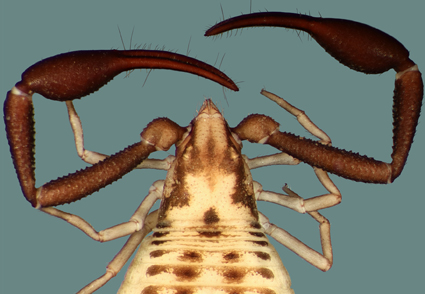Abstract
Two new species of Afrogarypus Beier, 1931, A. haddadi sp. nov. and A. pseudotriangularis sp. nov., and a new species of Geogarypus Chamberlin, 1930, G. grandis sp. nov. are described. Afrogarypus haddadi sp. nov. is diagnosed by a reduced isb and five rami on the female galea. Afrogarypus pseudotriangularis sp. nov. is diagnosed by trichobothria eb, esb, ib, est, isb, b, sb and st grouping within the first half of the fixed finger length and ten rami on the female galea. Geogarypus grandis sp. nov. is unique from the rest of its South African conspecifics in having two additional basal setae on the cheliceral hand, pedipalps densely ornamented with distinct protuberances and a unique protuberance at the base of the movable chelal finger. An updated identification key to the Geogarypidae species of South Africa is also presented.
References
- Adobe Inc. (2019) Adobe Photoshop. Available from: https://www.adobe.com/products/photoshop.html (accessed 27 March 2024)
- Beier, M. (1931) Neue Pseudoscorpione der U. O. Neobisiinea. Mitteilungen aus dem Zoologischen Museum in Berlin, 17, 299–318.
- Beier, M. (1932) Pseudoscorpionidea I. Subord. Chthoniinea et Neobisiinea. Tierreich, 57, 1–258. https://doi.org/10.1515/9783111435107.1
- Beier, M. (1955) Pseudoscorpionidea. In: Hanstrom, B., Brinck, P. & Rudebeck, G. (Eds.), South African Animal Life: Results of the Lund University Expedition in 1950–1951. Almquistand Wiksell, Stockholm, pp. 263–328.
- Beier, M. (1963) Ordnung Pseudoscorpionidea (Afterskorpione). In: D’Aguilar, J., Beier, M., Franz, I.H. & Raw, F. (Eds.), Bestimmungsbücher zur bodenfauna Europas I. Akademie-Verlag, Berlin, pp. 1–313. https://doi.org/10.1515/9783112475980-007
- Chamberlin, J.C. (1930) A synoptic classification of the false scorpions or chela-spinners, with a report on a cosmopolitan collection of the same. Part II. The Diplosphyronida (Arachnida-Chelonethida). The Annals and Magazine of Natural History, 10, 585–620. https://doi.org/10.1080/00222933008673173
- Harvey, M.S. (1986) The Australian Geogarypidae, new status, with a review of the generic classification (Arachnida: Pseudoscorpiones). Australian Journal of Zoology, 34, 753–778. https://doi.org/10.1071/ZO9860753
- Harvey, M.S. (1991) Catalogue of the Pseudoscorpionida. Manchester University Press, Manchester, New York, 726 pp.
- Harvey, M.S. (1992) The phylogeny and classification of the Pseudoscorpionida (Chelicerata: Arachnida). Invertebrate Taxonomy, 6, 1373–1435. https://doi.org/10.1071/IT9921373
- Harvey, M.S. (1996) The biogeography of Gondwanan pseudoscorpions (Arachnida). Revue suisse de Zoologie, Hors Série, 1, 255–264.
- Harvey, M.S. (2010) Redescription of Geogarypus irrugatus from Sumatra (Pseudoscorpiones: Geogarypidae). Journal of Arachnology, 38, 383–386. https://doi.org/10.1636/A08-101SC.1
- Heurtault, J. (1970) Pseudoscorpions du Tibesti (Tchad). II. Garypidae. Bulletin du Muséum National d’Histoire Naturelle, Paris, Series 2, 41, 1361–1366.
- Hu, J.F. & Zhang, F. (2012) Description of two new Stenohya species from China (Pseudoscorpiones, Neobisiidae). ZooKeys, 213, 79–91. https://doi.org/10.3897/zookeys.213.2237
- Judson, M.L.I. (2007) A new and endangered species of the pseudoscorpion genus Lagynochthonius from a cave in Vietnam, with notes on chelal morphology and the composition of the Tyrannochthoniini (Arachnida, Chelonethi, Chthoniidae). Zootaxa, 1627 (1), 53–68. https://doi.org/10.11646/zootaxa.1627.1.4
- Morikawa, K. (1960) Systematic studies of Japanese pseudoscorpions. Memoirs of Ehime University, Series 2B, 4, 85–172.
- Murthy, V.A. & Ananthakrishan, T.N. (1977) Indian Chelonethi. Oriental Insects Monograph, 4, 1–183.
- Neethling, J.A. & Haddad, C.R. (2016) A systematic revision of the South African pseudoscorpions of the family Geogarypidae (Arachnida: Pseudoscorpiones). Indago, 32, 1–80.
- Neethling, J.A. & Neethling, C. (2023) A systematic revision of the South African Gymnobisiidae (Pseudoscorpiones: Neobisioidea). Zootaxa, 5256 (6), 501–543. https://doi.org/10.11646/zootaxa.5256.6.1
- QGIS Development Team (2020). QGIS Geographic Information System. Open Source Geospatial Foundation. Available from: http://qgis.org (accessed 27 February 2024)
- Sivaraman, S. (1980) Pseudoscorpions from South India : A new genus and some new species of the super-family Garypoidea Chamberlin (Pseudoscorpionida : Diplosphyronida). Oriental Insects, 14, 325–343. https://doi.org/10.1080/00305316.1980.10434812
- World Pseudoscorpiones Catalog (2022) World Pseudoscorpiones Catalog. Natural History Museum Bern. Available from: https://wac.nmbe.ch/order/pseudoscorpiones/3, Gymnobisiidae from: https://wac.nmbe.ch/order/pseudoscorpiones/familydata/30 (accessed 10 December 2023)


